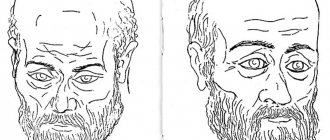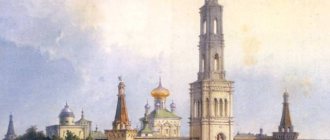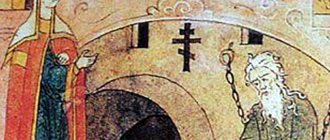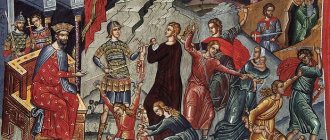Gogol is the most ecclesiastical writer in Russian literature
Hieromonk Simeon (Tomachinsky) - director of the Sretensky Monastery publishing house, candidate of philological sciences, author of a dissertation on Nikolai Vasilyevich Gogol.
On the eve of the writer’s 200th anniversary, Interfax-Religion correspondent Olga Kurova talked with Father Simeon about the Christian heritage of Gogol’s work. — Your Reverence, why is Gogol close to you, why did he become the topic of your dissertation?
— Gogol is close to me for many people. Firstly, my mother read it to me in very early childhood, and subsequently I often turned to Gogol’s works. Secondly, I also have Russian and Ukrainian blood mixed in me. And just as Gogol could not say which soul he had more - “Khokhlatsky or Russian,” as he put it, so I cannot say which is greater. And, of course, with his ascetic mood he influenced my decision to enter a monastery. It is known that Gogol lived like a monk, wanted to become a monk, and often came to Optina Pustyn, but Elder Macarius said that his works were more needed in the literary field. And in general, Gogol is the most ecclesiastical writer of the classics of Russian literature, the closest to the Church not only in ideas and worldview, but also in his life. Gogol not only took an active part in services, confessed, took communion, but also deeply studied church services. This is evidenced by his works, huge notebooks of his extracts from the patristic works, from the Menaion, from the Helmsman’s Book and, finally, his work “Reflections on the Divine Liturgy,” for the sake of which he specially studied the Greek language.
— Were they published in our time?
— “Reflections on the Divine Liturgy” was published. In Soviet times, however, this book was kept silent; the academic so-called “Complete Works” did not contain this work, although many researchers noted that it was marked by special lyricism; the reflection of Gogol’s very personality lies in this book. But in our time it was published, I re-read it with pleasure, it helps to understand what happens during the liturgy, what is the meaning of the sacred rites, chants, those prayers that the priest reads in the altar - everything is in great detail.
— So it can be a catechetical book for a modern person?
- Without a doubt. For those who want to understand the meaning of the Divine Liturgy, and not just contemplate what is happening in the temple, this is an excellent helper. The Optina elders also recommended reading it.
— What would you say about the evolution of Gogol’s views? How does early Gogol differ from late Gogol?
— There was a “concept of two Gogols”, which was put forward by Belinsky. According to it, the “early” Gogol is a wonderful artist who showed great promise, and then betrayed his calling, lost his mind, and the churchmen ruined him. This concept was generally accepted in Soviet times. But according to numerous studies that have appeared in the last two decades, primarily by scientists such as Vladimir Alekseevich Voropaev and others, this is an incorrect theory. Gogol's letters themselves, his attitude towards his works show that there was no sharp break in his worldview. He was always an Orthodox, church-going person, but, of course, youth is characterized by hobbies, he was in a creative search, he had a creative evolution. From cheerful Little Russian stories, “Evenings on a Farm near Dikanka,” Gogol moved on to more serious works. This is completely normal, natural for a genius, a great artist. In the mid-forties, he really had a spiritual crisis, which forced him to reconsider his attitude towards creativity, but the same “Taras Bulba”, the first edition, was written when Gogol was in his early twenties. Subsequently, he created a second edition, but all Christian ideas were already present in the first. And, say, “The Inspector General,” which many perceived simply as a satirical work exposing morals? Gogol repeatedly tried to explain that he put a deeper meaning into this work, that everyone should look at his own soul, that all these officials personify the passions that dominate a person, and a real auditor is a true conscience, as opposed to a “flighty conscience” , which Khlestakov personifies.
That spiritual meaning, those ideas that were not so clearly expressed in his early works, subsequently became more vivid in other genres in which Gogol began to work. It is unlawful to talk about some kind of contradiction between the “early” and “late” Gogol, and Gogol himself does not talk about it. Yes, he admits that some of his early works do not deserve so much attention, that Selected Passages from Correspondence with Friends is much more important for him, but he never renounces his past.
— How does Gogol’s Orthodoxy combine with all the devilry that he composed, including in his youth?
- This is a difficult question. As I have already said, in adulthood Gogol looked at his early work with different eyes. He writes that it becomes creepy from those fruits that we ourselves have grown without thinking, from those monsters that rise from our creations, which we never imagined. Gogol worried about much of what he wrote, although his early works did not contain any kind of theomachism or paganism. Perhaps Gogol's perception of Christian ideas in his youth was more superficial, as is often the case. Therefore, the actions of devilish forces were rather a matter of laughter for him, and he believed that one could joke with things that in fact should not be joked with. It was for this that he later repented.
— What would you say about Gogol as an imperial writer? He believed that all of Holy Rus' should have one language, the language of Pushkin. How realistic is it to celebrate his anniversary in the former Soviet republics, what will happen to Gogol’s legacy in Ukraine?
— I am sure that Gogol is read and loved in Ukraine. At the end of March we are going to the Gogol conference in Kyiv. And there will be more than one such conference, there will be many of them. Another thing is that in Ukraine nowadays Gogol is taught in a course on foreign literature - simply because he wrote in Russian. For modern Ukrainian authorities, Gogol as he is is inconvenient. Nikolai Vasilyevich believed that Russians and Ukrainians should be together, that these two nations complement each other, and great strength lies in their mutual unity. This is what he said in a private letter in 1844: “I would never give an advantage to a Little Russian over a Russian, or to a Russian over a Little Russian. Both natures are too generously endowed by God, and as if on purpose, each of them separately contains something that is not in the other - a clear sign that they must replenish one another. For this purpose, the very stories of their past life were given to them, unlike one another, so that the various forces of their character could be nurtured separately, so that later, merging together, they would form something most perfect in humanity.”
Gogol said about the Ukrainian language that it is excellent for Little Russian songs, pointing to its melodiousness and lyricism. But at the same time, he said, in particular, to his fellow countryman, the famous Slavist Bodyansky, that “we, Osip Maksimovich, need to write in Russian, we must strive to support and strengthen one, sovereign language for all our native tribes.” The Russian language absorbs numerous dialects; it can absorb and enrich itself with a variety of opposites, Gogol argued. For him there was no question what language the Slavs should have - of course, the language of Pushkin.
Unfortunately, now in Gogol’s homeland it is published in Ukrainian, where everything is mercilessly remade. Where the writer says “Russian land”, they write “Ukrainian land”, where the classic speaks about the strength of the Russian people, they write “Ukrainian people” and so on. His works are subjected to severe censorship, forcibly making Gogol some kind of rabid nationalist. This does not inspire respect; it is an outrage against the memory of the writer.
I hope that this anniversary will open people’s eyes to the fact that the great son of the Ukrainian people, Gogol, who endlessly loved his Motherland, wished it only goodness and prosperity, while saying that Ukraine should go hand in hand with Russia, that these are complementary nations, one cannot live without the other: “The Russian and the Little Russian are the souls of twins, replenishing each other, relatives and equally strong.”
— Will the cross on Gogol’s grave be restored? They wrote that an initiative group advocated for its restoration...
- Yes, the decision on this has already been made. In Russia there is an organizing committee for holding the celebrations; it was decided that a cross would be erected on Gogol’s grave in the Novodevichy Convent. It is known that Gogol was first buried in the Danilov Monastery - a memorial plaque will be installed there.
And, of course, a lot of other events are dedicated to the anniversary. Bortko’s film “Taras Bulba” is about to be released, which was filmed in Ukraine, where the Ukrainian Bogdan Stupka is playing the leading role. It seems that Ukraine is ready to show it at the box office. Namely, “Taras Bulba” contains the quintessence of Ukrainian history. The strength of the Ukrainian spirit lies in the defense of its faith, in the defense of Orthodox civilization and its identity. And the choice of the Cossacks, who fight against the Poles, against Latinism, is clearly in favor of the Orthodox faith.
Gogol seriously studied the history of Ukraine; he had a huge project “History of Little Russia”. He didn’t finish it, but there was a lot of interesting material left on this topic. Gogol didn’t write all this out of nowhere, he didn’t invent all this out of his head. He studied the history of the Ukrainian people, who in battles forged their national idea, which consisted, I repeat, in the defense of their faith and Orthodox civilization. And Russia, according to Gogol, after the fall of Constantinople, after the Arab-Muslim conquests, is the last and main stronghold of Orthodoxy, and only in alliance with it can Ukraine defend the Orthodox faith.
— Isn’t the Sretensky Monastery going to publish something for the writer’s anniversary?
— We have just published a volume of selected works by Gogol with a circulation of 5,000 copies. It included the stories “Taras Bulba”, “Portrait”, “Reflections on the Divine Liturgy”, religious and moral treatises, prayers, suicide notes. In the near future, in the series “Letters on Spiritual Life” we will publish selected Gogol’s letters. Gogol now needs to be published more, promoted more; in missionary terms, his work has enormous potential.
Under the protection of the saint of God
On March 19, 1809, in the town of Velikie Sorochintsy, Mirgorod district, Poltava province, a son, Nikolai, was born into the family of middle-income landowners Vasily Afanasyevich and Maria Ivanovna Gogol-Yanovsky. Three days later, the baby was baptized in the local Transfiguration Church. Gogol's mother, whose two children had previously died as soon as they were born, made a vow before the miraculous image of St. Nicholas, called Dikansky, that if she had a son, she would name him Nicholas, and asked the local priest to pray until he was notified about the birth of a child and will be asked to serve a thanksgiving prayer service. Requested by prayer, the newborn Nicholas was welcomed into this world with a prayer of thanksgiving to God. According to the writer’s sister, Olga Vasilievna Gogol-Golovnya, her brother loved to remember why they called him Nikolai.
Among Gogol's ancestors there were people of clergy: his paternal great-grandfather was a priest, his grandfather graduated from the Kyiv Theological Academy, and his father from the Poltava Seminary. Subsequently, Gogol visited the Holy Cross Monastery in Poltava, where the seminary was located.
Family legends determined Gogol's first concepts and beliefs. Maria Ivanovna told about the history of her marriage: “...they married me at the age of fourteen to my good husband, who lived seven miles from my parents. The Queen of Heaven showed me to him, appearing to him in a dream. He saw me then, not even a year old, and recognized me when he accidentally saw me at the same age, and followed me through all the ages of my childhood.”
Maria Ivanovna was distinguished by her piety. After the death of her husband in the spring of 1825, she wore mourning until the end of her life - “a dress made of the coarsest woolen product” - as if modeled on monastic hair shirts, and according to the testimony of people who knew her, she looked like the abbess of a monastery. Traditionally, the family had a pious custom of visiting, if possible on foot, holy places in Akhtyrka, Budishchi, Lubny, Voronezh, and Kyiv. But more often we went on pilgrimage to Dikanka, thirty miles from Vasilyevka.





